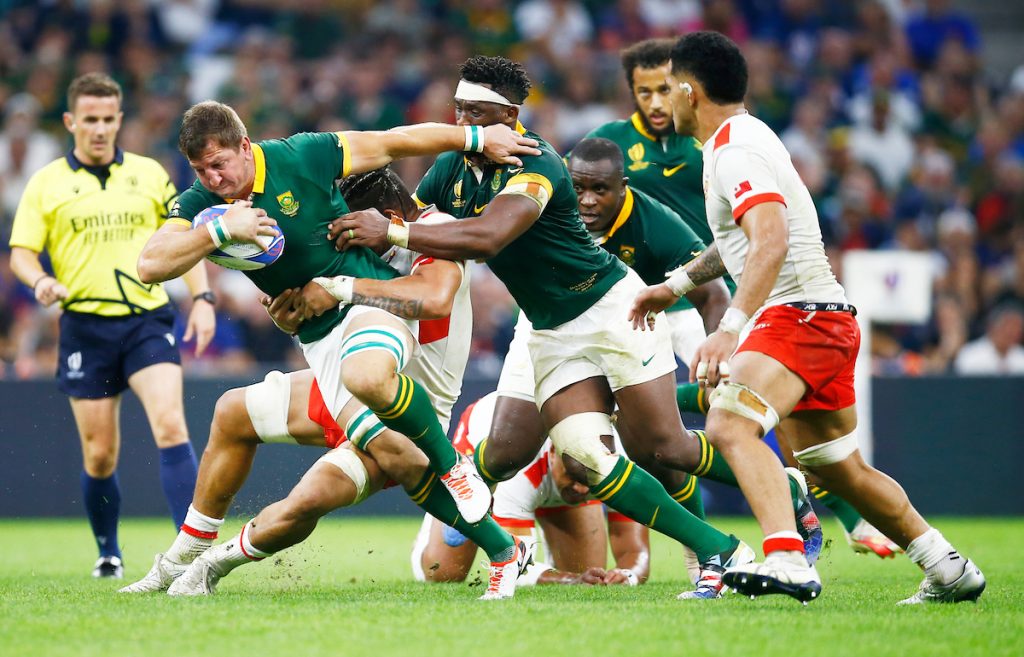
Our rugby scribe thinks there may just be a better option than sending these teams packing while the big guns duke it out for top honours.
I have to be brutally honest and admit that this is far from being my own idea. Whilst scrolling through the usual Monday morning sporting rubble, I came across a really intriguing piece that I forgot to bookmark and now can’t find, that suggested the knock-out phase go full on Sevens circuit style and introduce a second tier cup which features the 12 knock-out sides battling it out in a mini-pool phase and the four winners of the four newly drawn pools then squaring off in semi-finals and and a final.
It’s not a flawless system and it’s worth looking at the problems within it before moving to the cons.
The first issue is that it’s a whole lot of rugby to squeeze into a couple of weeks and you’d want to run it parallel with the knock-out phase of the tournament proper. That would give the organisers three weeks to schedule three three games per pool and then a round of semis and a final. So essentially you’re squeezing five weeks worth of rugby into three weeks, which means you’re going to have midweek games and players are going to be burdened with a far heavier workload.
There’s also the logistics of finding an extra four fields for two rounds but this could be negated somewhat, which I’ll discuss later. There may also be major opposition from clubs to this as they will want their players back before the European leagues get into the swing of things. Another issue may be attendance at the grounds with fan focus squarely on the big guns clashing in the quarter-finals, semis and finals.
Let’s move away from the negativity and onto the positives and some possible solutions to the problems in the paragraph above.
Firstly, an extra tier in the competition would give sides the opportunity to square off with opponents they don’t face on a regular basis and some of these opposition sides will be of a higher calibre than teams are used to playing. If we use this World Cup for example, Tier 1 sides Australia – not sure how much longer they’ll be in that top group – and Scotland could play against the likes of Chile and Portugal. These really low-ranked sides would not get a chance of facing the big boys anywhere else due to geographical issues.
To hammer this point home further, there’s been many pleas from Portugal skipper Tomas Appleton for his side to get regular games against higher ranked opposition in order for them to improve. And while this is a stop gap solution as it would only happen every four years, it would give the minnow sides more rugby against higher ranked opponents.
Speaking of Portugal, they were one of the real entertaining sides in the tournament. Yes, everyone loves an underdog success story and a draw with Georgia and a win over Fiji was certainly a triumph of note for the men from the Mediterranean, but the manner in which they played was the real factor that caught the eye. They were fearless at times and didn’t go into their shells when mixing it with the bigger guns. They were a real joy to watch, as were Uruguay who gave the French a real scare.
Numerous rugby fans would love to catch a couple extra games involving these exciting sides and these matches could be played at smaller venues – ala what they do in the Bunnings NPC – which would cut the cost of a match day ticket down and allow fans with smaller budgets a chance to catch more fixtures. This would also allow more cities to host games which would be a small boom for their local economies.
While there is likely to be some opposition from the European clubs, especially the French Top 14 behemoths, they may actually end up coming around as it’s an opportunity for them to identify new talent. There are a number of players from the minnow unions plying their trade in multiple divisions in France. Georgia has a number of Top 14 representatives while loads of Uruguyans, Romanians and Portuguese stars are playing in the Pro D1 and Pro D2. Extra games could put these players in the shop window to be picked up by some of the big guns.
The World Cup is likely to expand in 2027 with a proposal to add an extra team to each pool. While this will give the minnows more fixtures, it doesn’t solve the issue of the lopsided matches against the likes of New Zealand, South Africa and France.
A second tier knock-out phase would give minnows a chance to take on teams that are better than them but closer to them in quality. It also gives the rugby fan more oval ball action to observe. surely, there has to be some talk of this in the halls of World Rugby HQ?























